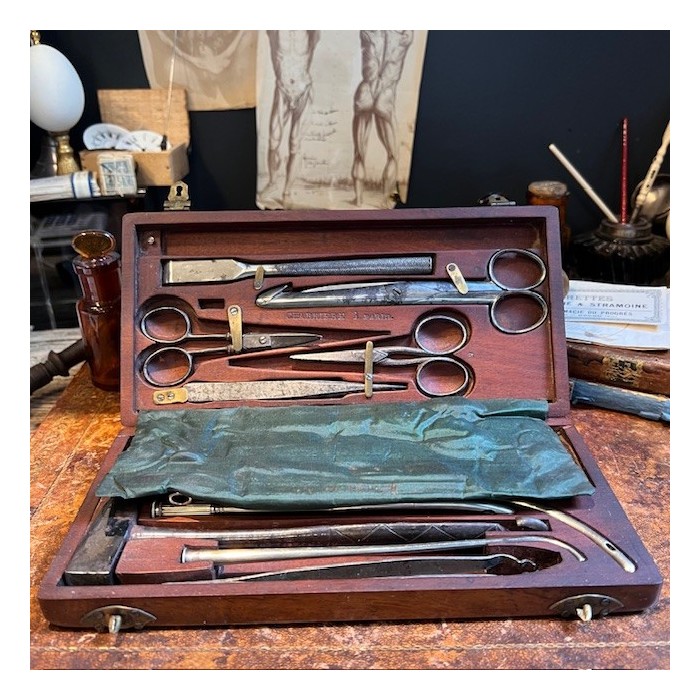- New
















































Portable autopsy kit from the mid-19th century
Maison Charrière in Paris, circa 1845–1870
Mahogany case for autopsy and dissection
Small portable mahogany case containing a set of autopsy instruments: hook hammer, bone chisel, enterotome scissors, probes, hooks and suture needles. Used by forensic scientists and anatomists for opening and examining bodies.
Charrière, a major 19th-century Parisian manufacturer, was a pioneer in the design of high-precision surgical and anatomical instruments.
Mahogany and polished steel: 23 × 11 cm
Please note: crack in the wood under the case
A beautiful object, very rare to find
Portable autopsy kit from the mid-19th century
From Maison Charrière in Paris - Marked in the wood inside the box.
Mahogany box for autopsy and dissection
This dissection and autopsy kit contains several instruments, three of which are original Charrière pieces: a hook hammer, a chisel or bone knife, and a pair of curved-blade enterotome scissors.
They are accompanied by probes, hooks, scissors, suture needles and small dissection accessories, stored in their compartments.
This type of small case (approx. 23 × 12 cm) was intended for forensic scientists, students, or anatomists for performing autopsies or limited dissections. Its compact size allowed for easy transport to anatomical lecture halls or hospitals, unlike the large surgical cases intended for major operations.
The difference with a simple box of instruments for operations on living bodies:
The following instruments reflect this specialisation in dissection on cadavers:
- The hook hammer is used to break bones, with the hook providing leverage on the bones and lifting the skull once it has been cut open.
- The bone chisel is used to open bone cavities (skull, sternum).
- Enterotome scissors are used to cut viscera or intestines without piercing them.
- Hooks and long probes are used to lift and explore organs.
- Very large sewing needles were used to close incisions made during autopsies, particularly on the chest or abdomen after examination of the organs. They had to pass through skin, muscle and sometimes thickened tissue, hence their strong steel construction. The needle was used with coarse thread or hemp string, sometimes even waxed thread, simply to keep the skin closed, without any consideration for aesthetics or healing. Some were slightly curved to better follow the shape of the body and facilitate freehand suturing. They are also called thanatopracteur needles or post-mortem closure needles.
These instruments are not used on living bodies because of the trauma they would cause.
The Charrière company, founded in Paris by Joseph-Frédéric-Benoît Charrière (1803–1876), was the most famous manufacturer of surgical instruments in the 19th century. As a supplier to Parisian hospitals, the army and medical schools, Charrière revolutionised the quality and precision of medical instruments. His cases, whether surgical or anatomical, are now highly sought after for their technical excellence and elegance.
This case perfectly illustrates the technicality and rigour of forensic practice in the 19th century, in a rare and beautifully authentic format.
The tools in both parts of the box are stored in their original moulded compartments under their original padded green silk cover, which is attached to a fabric hinge between the two levels of the box.
Dimensions: 23 × 11 cm
Please note: crack in the wood under the box
Period: circa 1845–1870
Manufacturer: Maison Charrière in Paris
A beautiful object, very rare to find